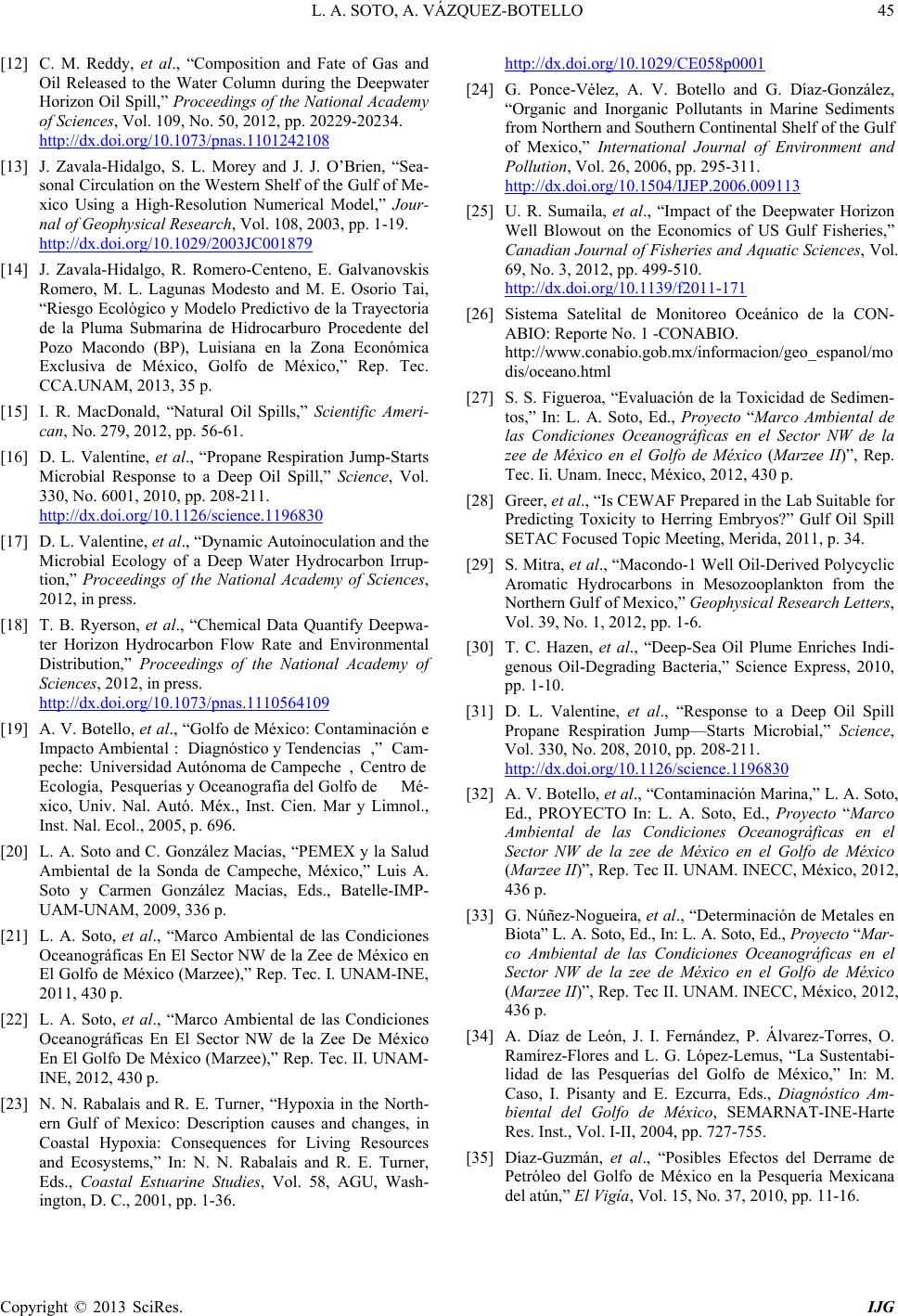
L. A. SOTO, A. VÁZQUEZ-BOTELLO
Copyright © 2013 SciRes. IJG
[12] C. M. Reddy, et al., “Composition and Fate of Gas and
Oil Released to the Water Column during the Deepwater
Horizon Oil Spi ll,” Proceedings of the National Academy
of Sciences, Vol. 109, No. 50, 2012, pp. 20229-20234.
http://dx.doi.org/10.1073/pnas.1101242108
[13] J. Zavala-Hidalgo, S. L. Morey and J. J. O’Brien, “Sea-
sonal Circulation on the Western Shelf of the Gulf of Me-
xico Using a High-Resolution Numerical Model,” Jour-
nal of Geophysical Research, Vol. 108, 2003, pp. 1-19.
http://dx.doi.org/10.1029/2003JC001879
[14] J. Zavala-Hidalgo, R. Romero-Centeno, E. Galvanovskis
Romero, M. L. Lagunas Modesto and M. E. Osorio Tai,
“Riesgo Ecológico y Modelo Predictivo de la Trayec toria
de la Pluma Submarina de Hidrocarburo Procedente del
Pozo Macondo (BP), Luisiana en la Zona Económica
Exclusiva de México, Golfo de México,” Rep. Tec.
CCA.UNAM, 2013, 35 p.
[15] I. R. MacDonald, “Natural Oil Spills,” Scientific Ameri-
can, No. 279, 2012, pp. 56-61.
[16] D. L. Valentine, et al., “Propane Respiration Jump-Starts
Microbial Response to a Deep Oil Spill,” Scienc e, Vol.
330, No. 6001, 2010, pp. 208-211.
http://dx.doi.org/10.1126/science.1196830
[17] D. L. Valentine, et al., “Dynamic Autoinoculation and the
Microbial Ecology of a Deep Water Hydrocarbon Irrup-
tion,” Proceedings of the National Academy of Sciences,
2012, in press.
[18] T. B. Ryerson, et al., “Chemical Data Quantify Deepwa-
ter Horizon Hydrocarbon Flow Rate and Environmental
Distribution,” Proceedings of the National Academy of
Sciences, 2012, in press.
http://dx.doi.org/10.1073/pnas.1110564109
[19] A. V. Botello, et al., “Golfo de México: Contaminación e
Impacto Ambiental: Diagnóstico y Tendencias,” Cam-
peche: Universidad Autónoma de Ca mpeche, Centro de
Ecología, Pesquerías y Oceanografía de l Golfo de Mé-
xico, Univ. Nal. Autó. Méx., Inst. Cien. Mar y Limnol.,
Inst. Nal. Eco l ., 2005, p. 696.
[20] L. A. Soto and C. González Macías, “PEMEX y la Salud
Ambiental de la Sonda de Campeche, México,” Luis A.
Soto y Carmen González Macías, Eds., Batelle-IMP-
UAM-UNAM, 2009, 336 p.
[21] L. A. Soto, et al., “Marco Ambiental de las Condiciones
Oceanográficas En El Sector NW de la Zee de México en
El Golfo de México (Marzee),” Rep. Tec. I. UNAM-INE,
2011, 430 p.
[22] L. A. Soto, et al., “Marco Ambiental de las Condiciones
Oceanográficas En El Sector NW de la Zee De México
En El Golfo De México (Marzee),” Rep. Tec. II. UNAM-
INE, 2012, 430 p.
[23] N. N. Rabalais and R. E. Turner, “Hypoxia in the North-
ern Gulf of Mexico: Description causes and changes, in
Coastal Hypoxia: Consequences for Living Resources
and Ecosystems,” In: N. N. Rabalais and R. E. Turner,
Eds., Coastal Estuarine Studies, Vol. 58, AGU, Wash-
ington, D. C., 2001, pp. 1-36.
http://dx.doi.org/10.1029/CE058p0001
[24] G. Ponce-Vélez, A. V. Botello and G. Díaz-González,
“Organic and Inorganic Pollutants in Marine Sediments
from Northern and Southern Continental Shelf of the Gulf
of Mexico,” International Journal of Environment and
Pollution, Vol. 26, 2006, pp. 295-311.
http://dx.doi.org/10.1504/IJEP.2006.009113
[25] U. R. Sumaila, et al., “Impact of the Deepwater Horizon
Well Blowout on the Economics of US Gulf Fisheries,”
Canadian Journal of Fisheries and Aquatic Sciences, Vol.
69, No. 3, 2012, pp. 499-510.
http://dx.doi.org/10.1139/f2011-171
[26] Sistema Satelital de Monitoreo Oceánico de la CON-
ABIO: Reporte No. 1 -CONAB IO.
http://www.conabio.gob.mx/informacion/geo_espanol/mo
dis/oceano.html
[27] S. S. Figueroa, “Evaluación de la Toxicidad de Sedimen-
tos,” In: L. A. Soto, Ed., Proyecto “Marco Ambiental de
las Condiciones Oceanográficas en el Sector NW de la
zee de México en el Golfo de México (Marzee II)”, Rep.
Tec. Ii. Unam. Inecc, México, 2012, 430 p.
[28] Greer, et al., “Is CEWAF Prepared in the Lab Suitable for
Predicting Toxicity to Herring Embryos?” Gulf Oil Spill
SETAC Focused Topic Meeting, Merida, 2011, p. 34.
[29] S. Mitra, e t al., “Macondo-1 Well Oil-Derive d Polycycli c
Aromatic Hydrocarbons in Mesozooplankton from the
Northern Gulf of Mexico,” Geophysical Research Letters,
Vol. 39, No. 1, 2012, pp. 1-6.
[30] T. C. Hazen, et al., “Deep-Sea Oil Plume Enriches Indi-
genous Oil-Degrading Bacteria,” Science Express, 2010,
pp. 1-10.
[31] D. L. Valentine, et al., “Response to a Deep Oil Spill
Propane Respiration Jump—Starts Microbial,” Science,
Vol. 330, No. 208, 2010, pp. 208-211.
http://dx.doi.org/10.1126/science.1196830
[32] A. V. Botello, et al., “Contaminación Marina,” L. A. Soto,
Ed., PROYECTO In: L. A. Soto, Ed., Proyecto “Marco
Ambiental de las Condiciones Oceanográficas en el
Sector NW de la zee de México en el Golfo de México
(Marzee II)”, Rep. Tec II. UNAM. INECC, México, 2012,
436 p.
[33] G. Núñez-Nogueira, et al ., “Determinación de Metales en
Biota” L. A. Soto, Ed., In: L. A. Soto, Ed., Proyecto “Mar-
co Ambiental de las Condiciones Oceanográficas en el
Sector NW de la zee de México en el Golfo de México
(Marzee II)”, Rep. Tec II. UNAM. INECC, México, 2012,
436 p.
[34] A. Díaz de León, J. I. Fernández, P. Álvarez-Torres, O.
Ramírez-Flores and L. G. López-Lemus, “La Sustentabi-
lidad de las Pesquerías del Golfo de México,” In: M.
Caso, I. Pisanty and E. Ezcurra, Eds., Diagnóstico Am-
biental del Golfo de México, SEMARNAT-INE -Harte
Res. Inst., Vol. I-II, 2004, pp. 727-755.
[35] Díaz-Guzmán, et al., “Posibles Efectos del Derrame de
Petróleo del Golfo de México en la Pesquería Mexicana
del atún,” El Vigía, Vol. 15, No. 37, 2010, pp. 11-16.